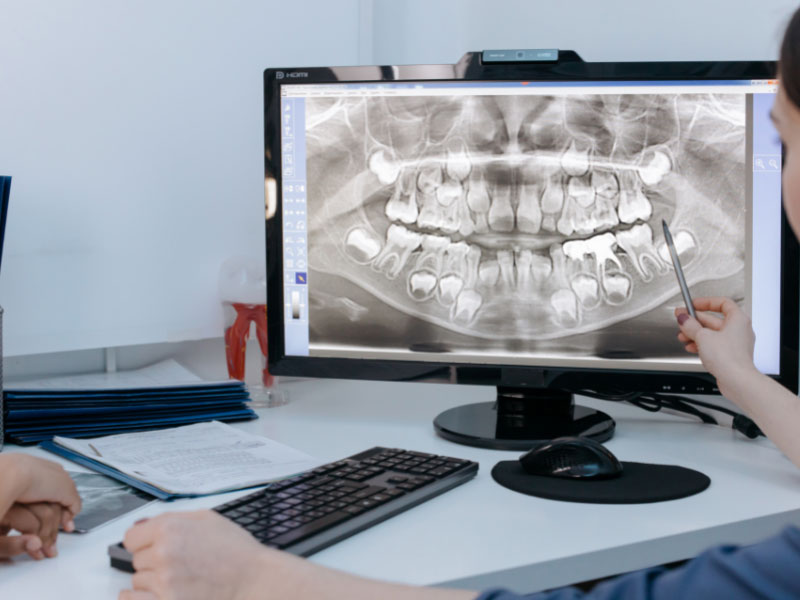Why We Use Digital X-Rays

Alright, let’s start out with the basics, what exactly is a digital x-ray? Also called digital radiography, digital x-rays are a modern type of technology that use digital sensors rather than photographic film which is what is used with traditional x-rays. When getting a digital x-ray, after the image is taken, it is converted into digital data that is available for review the doctor to review immediately on a computer screen. The process for digital x-rays however, is similar to what you may have experienced previously when getting traditional x-rays. At Willow Springs Dental, we utilize Dexis digital x-rays over traditional x-rays for the betterment of our patients and the quality of their care. Stick around and we’ll give you the details on why!
Digital X-Rays vs. Traditional X-Rays
The first thing that comes to mind for most people when they think of traditional x-rays is that big, heavy, lead apron you’re required to wear in order to protect your body and the surrounding areas from the radiation coming from the x-ray. This is a great example of one of the reasons we use digital x-rays in our office. Traditional x-ray imaging generates images with the use of ionizing radiation, which is a form of radiation that has enough energy to potentially cause damage to DNA. This exposure can put you at risk for the possibility of negative tissue effects such as cataracts, skin reddening, hair loss, even the increased risk of developing cancer later in your life (Food and Drug Administration, 2023). Now we’re not here to scare you or give you any misinformation, so it is important to point out that these risks depend on a multitude of factors including a patient’s, age, sex, and radiation dose. On top of that, the risk for these negative side effects is very minimal. The choice to use digital x-rays over traditional x-rays really just helps us to do our part in helping minimize the amount of radiation exposure to our patients over the years.
In terms of how digital x-rays work compared to traditional x-rays, the process is fairly similar, but digital x-rays utilize a sensor that is put into the patient’s mouth to help capture images of their teeth. Though it resembles that which is used for traditional x-rays, the digitized sensor is actually just a device linked to a computer whereas the sensor for traditional x-rays is connected to film. With both traditional and digital x-rays, the purpose is to capture images of your teeth, gums, and surrounding bones in your mouth so your dentist can get a better view of what is going on inside of your mouth, more easily being able to diagnose any dental health issues you may have as well as then determining the best treatment plan for you moving forward.
The Benefits of Digital X-Rays
X-Ray pictures are a critical tool for dentists needing to evaluate and diagnose oral health problems that would otherwise not be able to be diagnosed by simply doing a regular dental exam. Attending a dental clinic such as Willow Springs Dental that makes utilizes digital radiography comes with a number of advantages such as the benefits listed below:
Decreased Radiation Exposure:
As we mentioned before, one of the biggest downsides of traditional x-rays is the amount of radiation exposure, which our patients are often concerned about. With the use of digital x-rays, we are able to decrease the amount of radiation exposure to our patients by over 70% compared to traditional film x-rays. There is also decreased exposure to radiation due to the fact that there are less situations that would require retakes, compared to the various reasons you may need a retake with traditional x-rays such as poor posture, or inadequate exposure. Even with the much smaller dose of radiation with digital x-rays, many dentists will still use lead aprons as an added protection and to decrease the exposure to radiation even that much more.
Immediate Results:
Digital x-rays help with timeliness during our office appointments because unlike traditional x-rays, dentists are able to view the digital photographs immediately after the x-rays are taken. The images appear on the computer screen attached to the sensor allowing for dentists to evaluate the images and make a diagnosis much faster than with traditional x-rays. Not only does this help save time, but it is helpful for dentists when they are doing operations and need information instantly.
Heightened Images:
Digital radiography comes with software that is capable of enhancing images effortlessly. It has the ability to not only adjust the scale of the images, but make changes to brightness, contrast, and clarity. This greatly assists the dentist to be able to see the imaging more clearly and in more detail, making it easier and faster to identify problem areas, and therefore the resolution and treatment plan moving forward. Enhanced imaging not only helps the doctors but is helpful when for our patients when reviewing their x-rays with the dentist. It’s much simpler to explain the situation when the patient is able to have a clear visualization of what is going on inside their mouth.
Efficient:
Digital x-rays are not only efficient because of their timeliness, but because of their storage and quick sharing abilities. You no longer have to keep track of your physical x-ray images, sort through old files, or risk losing or misplacing them. The images can be stored on a hard drive with appropriate security to keep them safe while also allowing doctors to easily access and share images while consulting with other experts when needed.
Digital X-Rays at Your Las Vegas Dentist
Willow Springs Dentistry is proud to serve the Summerlin community, providing top care that keeps our patients’ health, wellbeing, and best interest at heart. We believe everyone deserves a happy and healthy smile that makes them feel confident. Give us a call at 702-867-2745 or schedule a consultation today and let us take care of you and your smile!



